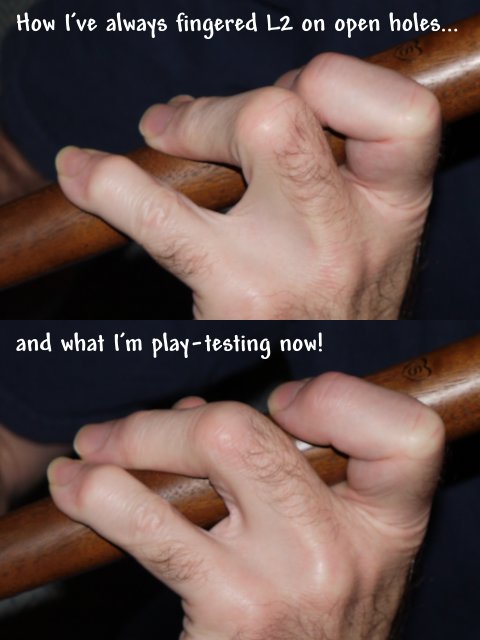Denny wrote:well, ya know we're gonna want pictures...
And how sorry I am you never got to see them, Denny!
So here
(fresh fifteen-month thread revival alert!) is the update I should have had up a year ago after getting the flute in December 2012. But we had a few small problems with the wood of the middle and foot joints and, taking that alongside a week or two's evaluation of the hole positions and keywork, I put it to Dave that we might 'regard the middle joint as a (rather fine!) prototype when the layout is so nearly (but not quite!) brilliant and build a new one with revamped G# and F keys and blocks' with some appropriate (to be agreed) adjustment to the pricing. And Dave was willing, meeting me in the UK for a second time in May 2013 to check the finer points, taking the flute home with him and building the 'Mark 2' which I finally received this Christmas. And here at last (photos first, then description) is the 'flute for life' I was hoping to get...


 Notes
Notes
One-piece body to accommodate the RH G# key (a solution Dave thought vastly superior to the LH options I'd been considering and for which I thank him!).
LH holes rotated slightly (5 degrees) towards the player (something I discovered through experimentation with my two-piece Delrin keyless bodies to work well for my LH configuration with the big L3 pinkie offset).
Thumb hole brought higher than Dave's standard position (something we got right from the start as being affected by the size of L3 offset).
L3 hole restored to its original size and position along the tube when the 'Mark 1' was spec'd with Dave's closer spacing/smaller hole largely because I was still thinking in terms of a modified L3 G# and forgot I didn't need that adjustment anymore!
'Mark 2' G# key brought as high as we dared where I found the 'Mark 1' (which was rather lower) to respond well to a raised R1 movement but not to the tipping motion off the G hole I'd also really hoped would work. And this is just brilliant, with the key now opening perfectly this way, feelable under the finger when playing the lower notes but never leaking accidentally. No downsides at all apart from the already-anticipated adjustment (with almost any RH G#?) in making F#-to-G slides by sliding the finger towards the foot rather than tipping off the hole (which now produces G#) and even a
slight adjustment to the previously perfect Bb key position to accommodate the higher G# having no adverse effect.
'Mark 2' F key beefed up where it goes through the block after I became concerned about the original developing play from the hammering it was getting from my D-to-F and Eb-to-F movements. (NB we'd always had the key as a mirror image of the 'standard' one for reasons of aesthetics and possible physical balance where we'd otherwise have ended up with all four keys to the player side.)
And that's it, folks... this flute is brilliant and I don't know why everyone doesn't have a RH G#! Hopefully get some video made sometime to show all this stuff in operation, but just wanted to get this long-overdue update up first.
daiv wrote:So I was reading the first page or two and thinking to myself that Dave would be the perfect person to talk to about something like this. Glad you found him on your own! Best of luck,

Yep, the perfect person when he's been so patient with my musings, generous (I was expecting to pay for the 'Mark 2', but...), full of good ideas, and we've come up with this beautiful flute together. But sure we've also both learned so much about how to do this along the way!




